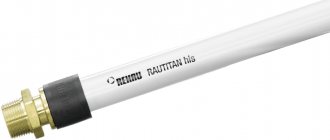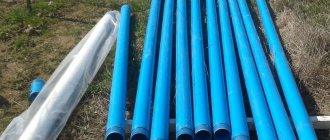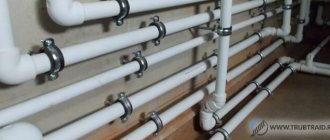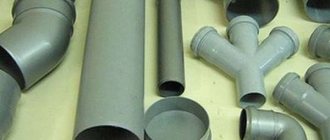To prevent pipes from freezing in the winter, you need to choose them correctly. Water in pipes freezes from the inside at temperatures below -7 degrees Celsius. When water freezes, according to the laws of physics it expands. This is the main reason for burst pipes in the winter season. Therefore, it is necessary to identify in advance places in the house where the temperature could potentially drop below -7 degrees and prevent freezing. After all, this temperature can easily freeze the water in the pipes in your home. When making a well or well, you need to think in advance about the water supply system for your home.
- An effective way to heat water in a plastic pipe
- The main question is how not to defrost a container of water
- How to warm a frozen water supply: 4 effective ways
- How is it prohibited to heat process pipelines - dangerous methods
- At what temperature does water freeze in pipes: saving pipes from freezing (video)
If, after all, the pipe is frozen and damaged, then it will have to be replaced. This is extra spending from your wallet. If the tube is simply frozen and there is no damage, then you can try to warm it up. Therefore, it is worth taking care of problem areas on the street underground where your pipes run.
You should check the basement of your home. If it is too cold in winter, then you should think about additional heating of the basement. Next, you should insulate all doors and windows to prevent cold air from spreading throughout your home. These rules will help prevent the temperature in the house from dropping and, accordingly, pipes from freezing.
An effective way to heat water in a plastic pipe
In many houses, water supply is carried out through plastic pipes. If you find that your pipe is frozen in winter, you should warm it up thoroughly.
In order to do this, you will have to take:
- hardened steel wire with a diameter of 3 mm;
- long hydraulic level;
- enema;
- 100 liters of boiling water;
- metal bucket;
- wire cutters;
- two-core copper wire;
- a regular plug for a socket;
- pump;
- irrigation hose;
- a pipe with a tap at the end;
- 100 liter barrel;
- boiler.
Merelon is a pipe insulation that acts as frost protection
First of all, make the wire straight. Prepare a hydraulic level. Wrap one end of the wire into a loop. Use electrical tape to connect the loop to the hydraulic level tube. The head of the level should extend 1 centimeter. Take electrical tape and connect the wire to the level for the entire length. Attach the remaining end of the hydraulic level to the enema. Now insert the wire with the tube into the plastic pipe where your water is frozen. Move it until you feel that you have hit the ice. Now introduce boiling water using an enema and push the wire inside the pipe. Place a bucket at the end of the pipeline to allow cold water to flow.
Next, remove the insulation from the copper wire. Make a few turns of the bare wire at the end. Make the turns in such a way that they are tight to each other. Use pliers to cut off the excess part. Bare the second part of the wire and wind it in the same way as written above. In the end, you will end up with a device called a “burbulator”.
Method one: defrost the pipe using a miniature boiler
If you decide to use these methods, then take safety precautions.
- When using a public water supply or well, warn your closest neighbors not to turn on the water while you are defrosting.
- Defrost from the top of the pipe. This is important, since you cannot allow melted melt water to drain under voltage - this is a guaranteed electric shock!
- Turn off the tap.
To make a boiler you will need:
- rigid two-core cable – 2*2.5–4.0 mm (copper, aluminum);
- plug;
- single-phase circuit breaker for 10 amperes;
- insulating tape.
The cable is suitable for both two-core and three-core cables - a third core is not needed.
The machine is needed to avoid short circuits and overheating of the wire - it will not be cost-effective to throw it away after the first use. And also, the use of an automatic circuit breaker will not allow the house to be de-energized in the event of a short circuit. The 10 ampere switch is taken from the approximate performance of the device - it does not exceed 250 watts.
The length of the cable must be calculated from the length of the water pipe. The principle here is simple - the further the plug, the longer the wire.
What should be done
- Install a plug on one end of the wire.
- Mount the machine on one wire at a distance of 30–50 centimeters from the plug. It is advisable to install it in a protective box, but if there is none, then insulate the open areas.
- Strip the other end of the wire from the braid by 20 cm, expose it by 7–10 cm, and then make two insulated coils from each exposed wire. The number of turns on the coil is 3–6. The more turns, the more powerful the device. The distance between the coils is 1.2–1.5 cm.
The device is ready - let's move on to defrosting
Be sure to turn off the water! When thawing, water will rush out of the pipe under pressure. This is dangerous because there is an electrical device with exposed elements operating inside.
The first step is to disconnect the pipe at the top point and open access to the water supply. It is better to carry out the procedure from home.
The remaining water must be drained from the disconnected pipe - the work area must be dry. If there is water in the lower, frozen pipe to the brim, you should pump it out a little so that it does not come out when boiling.
Next, use the unconnected wire to feel for the ice plug. When the wire rests against it, plug the device into the outlet.
Water is heated depending on its quantity in the water pipeline. This may take 5–15 minutes.
After the water has heated up and the ice has begun to melt, move the boiler close to the ice plug. It is necessary to push the boiler until it thaws completely.
Useful tips
If a large section of the water pipeline is frozen and it takes more than 20 minutes to defrost, then it is advisable to interrupt the procedure for 5–10 minutes.
For greater efficiency, pour salt water into the pipe. It has better electrical conductivity and will increase the power of the boiler.
The main question is how not to defrost a container of water
One of the popular old-fashioned methods for not defrosting a container of water is the use of logs. To do this, put the logs into the container. Today, instead of such logs, ordinary plastic bottles are already used. They are covered with sand, closed with a cork and left in a container with water for the whole winter.
Plastic bottles should be left half empty - only fill them halfway with sand.
There is another method to avoid defrosting a container of water. To do this, you need to dig a hole of 2 cubic meters. Next, cover it in two layers of polyethylene. It should be thick and durable. We lower a container of water into the hole and bury it. It is allowed to leave a couple of centimeters of the container on the surface.
Today, these two methods are the most common among summer residents.
Testing PP pipes for frost resistance
The American company, upon request, tested Aquatherm Green Pipe PP pipes to ensure their frost resistance. For comparison, together with Fusiotherm pipes D=20 and D=32 mm, copper pipes of the same diameter were tested, which, unlike steel ones, are considered ductile and frost-resistant.
The samples were filled with water and closed at the ends. In this state, they underwent tests consisting of 10 cycles without a break. One cycle is a stay in a cooled chamber (down to -54 o C) for 16 hours, and then at room temperature for 8 hours.
Copper samples cracked after the first freezing, but polypropylene pipes successfully withstood all 10 cycles. This became possible because when water freezes, Fusiotherm polypropylene pipes expand, and after thawing, they return to their previous shape.
How to warm a frozen water supply: 4 effective ways
When the outside temperature drops below normal and you notice that the water supply is frozen, do not rush to buy new pipes. There are proven ways to help you deal with this problem.
Using hot water
If you find or are 100% sure that a section of your water supply is frozen in an “open” place where you can use boiling water to heat the pipe, then use boiling water. Before doing this, take a rag and wrap the pipe around it. It will take all the water and increase the time the boiling water interacts with the pipe. Pour hot water until the ice completely melts. To speed up the process, you can turn on the tap.
The method is good for indoors. If your underground non-freezing pipeline is frozen, then boiling water will clearly not help. You will have to heat the pipe in this way for more than 10 hours so that the ice can thaw.
Use a hair dryer
With the help of hot air from a hair dryer, the ice can be easily melted. Owners of such hair dryers recommend hanging plastic film over the heating pipe. This way, heat losses will be reduced significantly, which will allow the hair dryer to work more efficiently. You can also use a hair dryer with a steam generator.
When heating the water supply using a hair dryer, the frozen water will quickly turn into liquid and flow out of the pipe
To do this, use a welding machine. To heat a pipe in this way, you need to connect one wire (plus) to one end of the pipe, and the second (minus) to the other end. In just a couple of minutes the ice will melt. The operating principle of this method is similar to a boiler. The advantage of using electric current is that only the water is heated. The transformer wires remain cold. This will prevent the plastic pipe from melting with the water. The downside of this method is that you need a transformer.
Find specialists
You don’t have to suffer on your own, but simply call professionals. They will have special means for warming up the ice. For example, a hydrodynamic installation. It cleans not only water pipes, but also sewer pipes. The installation supplies hot water under powerful pressure, from which the ice gradually melts. At high pressure, the ice in the pipe disappears very quickly.
Will summer water pipes made of reinforced polypropylene break?
Hello. Please tell me. Do reinforced polypropylene pipes tear in winter? I want to install a new summer water supply for the area, the pipe will be 20.
It’s still not possible to drain the water - frosts come unexpectedly










